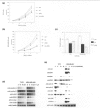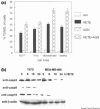A retinoid X receptor (RXR)-selective retinoid reveals that RXR-alpha is potentially a therapeutic target in breast cancer cell lines, and that it potentiates antiproliferative and apoptotic responses to peroxisome proliferator-activated receptor ligands
- PMID: 15318936
- PMCID: PMC549174
- DOI: 10.1186/bcr913
A retinoid X receptor (RXR)-selective retinoid reveals that RXR-alpha is potentially a therapeutic target in breast cancer cell lines, and that it potentiates antiproliferative and apoptotic responses to peroxisome proliferator-activated receptor ligands
Abstract
Introduction: Certain lipids have been shown to be ligands for a subgroup of the nuclear hormone receptor superfamily known as the peroxisome proliferator-activated receptors (PPARs). Ligands for these transcription factors have been used in experimental cancer therapies. PPARs heterodimerize and bind DNA with retinoid X receptors (RXRs), which have homology to other members of the nuclear receptor superfamily. Retinoids have been found to be effective in treating many types of cancer. However, many breast cancers become resistant to the chemotherapeutic effects of these drugs. Recently, RXR-selective ligands were discovered that inhibited proliferation of all-trans retinoic acid resistant breast cancer cells in vitro and caused regression of the disease in animal models. There are few published studies on the efficacy of combined therapy using PPAR and RXR ligands for breast cancer prevention or treatment.
Methods: We determined the effects of selective PPAR and RXR ligands on established human breast cancer cell lines in vitro.
Results: PPAR-alpha and PPAR-gamma ligands induced apoptotic and antiproliferative responses in human breast cancer cell lines, respectively, which were associated with specific changes in gene expression. These responses were potentiated by the RXR-selective ligand AGN194204. Interestingly, RXR-alpha-overexpressing retinoic acid resistant breast cancer cell lines were more sensitive to the effects of the RXR-selective compound.
Conclusion: RXR-selective retinoids can potentiate the antiproliferative and apoptotic responses of breast cancer cell lines to PPAR ligands.
Figures




Similar articles
-
Regulation of retinoic acid receptor beta expression by peroxisome proliferator-activated receptor gamma ligands in cancer cells.Cancer Res. 2003 Jul 1;63(13):3531-8. Cancer Res. 2003. PMID: 12839938
-
Inhibition of trans-retinoic acid-resistant human breast cancer cell growth by retinoid X receptor-selective retinoids.Mol Cell Biol. 1997 Nov;17(11):6598-608. doi: 10.1128/MCB.17.11.6598. Mol Cell Biol. 1997. PMID: 9343423 Free PMC article.
-
Suppression of human pancreatic cancer cell proliferation by AGN194204, an RXR-selective retinoid.Carcinogenesis. 2004 Aug;25(8):1377-85. doi: 10.1093/carcin/bgh122. Epub 2004 Feb 19. Carcinogenesis. 2004. PMID: 14976133
-
Linkage between retinoid and fatty acid receptors: implications for breast cancer prevention.Eur J Cancer Prev. 2002 Aug;11(4):319-25. doi: 10.1097/00008469-200208000-00002. Eur J Cancer Prev. 2002. PMID: 12195157 Review.
-
The retinoid receptors.Leukemia. 1994 Nov;8(11):1797-806. Leukemia. 1994. PMID: 7967725 Review.
Cited by
-
A novel dysregulated pathway-identification analysis based on global influence of within-pathway effects and crosstalk between pathways.J R Soc Interface. 2015 Jan 6;12(102):20140937. doi: 10.1098/rsif.2014.0937. J R Soc Interface. 2015. PMID: 25551156 Free PMC article.
-
ATM-Inhibitor AZD1390 Is a Radiosensitizer for Breast Cancer CNS Metastasis.Clin Cancer Res. 2023 Nov 1;29(21):4492-4503. doi: 10.1158/1078-0432.CCR-23-0290. Clin Cancer Res. 2023. PMID: 37585496 Free PMC article.
-
Peroxisome Proliferator-Activated Receptors and the Hallmarks of Cancer.Cells. 2022 Aug 5;11(15):2432. doi: 10.3390/cells11152432. Cells. 2022. PMID: 35954274 Free PMC article. Review.
-
PPARgamma in Neuroblastoma.PPAR Res. 2008;2008:917815. doi: 10.1155/2008/917815. PPAR Res. 2008. PMID: 18528516 Free PMC article.
-
Human pregnane X receptor is expressed in breast carcinomas, potential heterodimers formation between hPXR and RXR-alpha.BMC Cancer. 2008 Jun 19;8:174. doi: 10.1186/1471-2407-8-174. BMC Cancer. 2008. PMID: 18565212 Free PMC article.
References
Publication types
MeSH terms
Substances
LinkOut - more resources
Full Text Sources
Other Literature Sources
Medical

